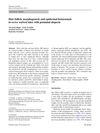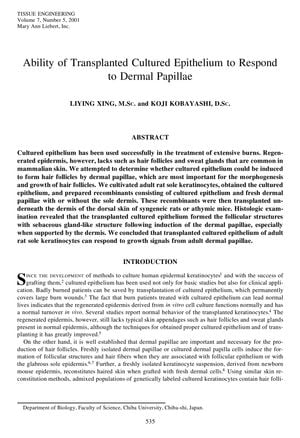TLDR Cultured epithelium can form hair follicles when combined with dermal papillae.
The study investigated whether cultured epithelium could form hair follicles when combined with dermal papillae. Researchers cultivated adult rat sole keratinocytes and created recombinants with fresh dermal papillae, which were then transplanted into syngeneic rats or athymic mice. Histological analysis showed that the transplanted cultured epithelium developed follicular structures and sebaceous gland-like structures, particularly when supported by the dermis. The conclusion was that cultured epithelium from adult rat sole keratinocytes could respond to growth signals from dermal papillae, indicating potential for hair follicle formation.
949 citations
,
January 2001 in “Cell” Adult mouse skin contains stem cells that can create new hair, skin, and oil glands.
1010 citations
,
August 2000 in “Cell” Hair follicle stem cells can form both hair follicles and skin.
 57 citations
,
November 1998 in “Wound Repair and Regeneration”
57 citations
,
November 1998 in “Wound Repair and Regeneration” Hair papilla cells can create and regenerate hair bulbs under the right conditions.
31 citations
,
September 1996 in “Differentiation” The upper dermal sheath can regenerate hair in rats.
28 citations
,
July 1993 in “The journal of investigative dermatology/Journal of investigative dermatology” Dermal papilla cells are crucial for hair growth and can induce new hair follicles.
38 citations
,
January 1988
 7 citations
,
November 2014 in “Histochemistry and Cell Biology”
7 citations
,
November 2014 in “Histochemistry and Cell Biology” The we/we wal/wal mice have defects in hair growth and skin layer formation, causing hair loss, useful for understanding alopecia.
21 citations
,
December 1994 in “British Journal of Dermatology” Sheep dermal papillae can help form hair follicles in skin models.
125 citations
,
August 1992 in “Development” Implanted dermal papillae can induce hair growth in rat ear wounds.
65 citations
,
October 1988 in “Clinics in dermatology” The dermal papilla interacts with the epidermis to control hair growth and development.


